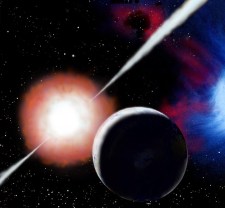Meeting Organization

Artist's conception of the tremendous explosion known as GRB 030329 as seen from a hypothetical nearby planet. Observations proved that a hypernova explosion, much more violent and energetic than a typical supernova, was the source of the gamma-ray burst. (Credit: David A. Aguilar, Harvard-Smithsonian Center for Astrophysics)
One of the goals of this meeting is to bring together astronomers
working on the most massive stars, especially the most evolved
unstable ones with those working on the final stages, supernovae,
and GRB's. We are bringing together two communities so we have tried to
structure the meeting to encourage discussion, exchange of ideas and to
make each community aware of the outstanding questions.
Each session will include 3 or 4 review talks of 30 to 40 minutes
length followed by a discussion session of an hour or more. Part of
each discussion will be focused around one or more outstanding questions
or controversies for each topical session. All of the participants
will know what these are in advance. Participants will be invited to
to come prepared to "contribute" to the discussion. Because this is an
open discussion, others may join in at any time with their own ideas,
and other topics and questions may be added.
There will also be space for poster papers.
Program Outline and Schedule
The Fate of the Most Massive Stars
(names in parenthesis have not confirmed)
Sunday Evening
6 - 8 pm Reception with cash bar
Monday Morning
- Introduction to the Meeting
- Welcome and Introductory Remarks — R. Humphreys
- Evolution (> 50-60 Msun) near the Eddington Limit — A. Maeder
- Instabilities in the Most Massive Evolved Stars — W. Glatzel
- Eta Carinae 1600 to 2004—the Observational Story — R. Humphreys
- Supernovae and Their Massive Stars Progenitors — A. Filippenko
Monday Afternoon
- The SNe Imposters
- The eta Car Analogs — S. Van Dyk
- The “Pistol Star” and unstable massive stars at the Galactic Center — P. Najarro
- SN1961v — Y-H. Chu
- Simulations of an SNe Imposter — D. Arnett
- Discussion and contributions
Tuesday Morning
- Eta Carinae—Close-up of an Impostor
- Multi-Wavelength Variability
- Optical since 1950 — J. Martin
- Infrared — P. Whitelock
- The 5.5 year cycle (spectroscopy since 1946) — A. Damineli
- Radio — S. White
- X ray — M. Corcoran
- Multiple Eruptions — K. Ishibashi
- The Nature of the Central Star — K. Davidson
- A Spectroscopic Event Viewed from Different Directions — O. Stahl
- Discussion with contributions
Tuesday Afternoon
- Physics of the Instability—Beyond the Eddington Limit
- Radiative Driven Winds and Asymmetric Mass Loss — S. Owocki
- Exceeding the Eddington Limit — N. Shaviv
- Massive Star Evolution with Hydrodynamic Ejection — P. Young
- Discussion with contributions
- J. Bjorkman
- K. Gayley
- J. Guzik
Wednesday Morning
- Evolution—rotation, mass loss, non-spherical stars, metallicity and relation to first stars
- Mass Loss and Winds from the Most Massive Stars — J. Hillier
- Evolution at Very Low and Zero Z — G. Meynet
- Mass Loss, Winds and Instabilities at Low Metallicity — R. Kudritzki
- The First Stars — T. Abel
- Discussion with contributions
Wednesday Afternoon
Recreation Break
Thursday Morning
- The Environments Created by Massive Eruptions
- Close-up of the Ejecta—Strange phenomena in the Homunculus Nebula: Dynamics, nebular physics, unfamiliar atomic processes
- The Outer Ejecta of Eta Car — K. Weis
- The Immediate Environment of the Central Star — T. Gull
- Unusual Excitation Processes in Eta Car and Other Extreme Environments — G. Ferland
- Diagnostics in the Ejecta — F. Hamann
- Dust Formation in SNe and Massive Star Eruptions
- Dust in the Homunculus of eta Car — N. Smith
- Dust in SNRs — M. Edmunds
- Discussion with contributions
- V. Dwarkadas
- J. Meaburn
- A. de Koter
Thursday Afternoon
- The Final Stages of the Most Massive Stars I—SNe
- Final Stages of the Most Massive Stars — A. Heger
- The Role of Rotation in Supernovae — A. Burrows
- Core-Collpase Supernova Modeling: Progress, Problems, Perspectives — T. Janka
- Very Energetic SNe (Hypernovae) — K. Nomoto
- Discussion with contributions
Thursday Evening
Cash Bar — 7:00pm
Conference Dinner (Western BBQ) — 7:30pm
Friday Morning
- The Final Stages of the Most Massive Stars II—GRBs
- The SNe/GRB Connection—the observations — P. Garnavich
- The Collapsar Model, limitations and requirements — S. Woosley
- Collapsars and Jet-Driven Supernovae — A. MacFadyen
- Discussion with contributions
- W. Zhang
- T. Matheson
- R. Perna
- Summing Up — D. Arnett
©2003,2004 The University of Minnesota

